June 3 was a historical moment for Hearthstone. For the first time since the game’s release (which was over 5 years ago) we’ve seen a new kind of balance update. Instead of nerfing cards, Blizzard decided to buff a bunch of underplayed Class minions and spells from The Boomsday Project. And almost 3 weeks after the buffs went live, I’m absolutely sure that it was a great initiative.
Overall, the buffs were much more impactful than I thought they would be. While I was absolutely sure that cards that were already solid and have seen some play in the past (e.g. Thunderhead or Crystology) will become even more relevant, I didn’t expect that cards which were basically unplayable before will make a comeback. Of course – buffs weren’t perfect. A few out of the 18 see exactly just as much play as they did before (which is virtually zero) even though they became cheaper / have better stats. But given how much they impacted the meta, overall I have to say that they were successful.
Given that the meta has pretty much stabilized, and since the new expansion is only ~1.5 months away we won’t likely see any bigger shifts until then, I can now rate how impactful each of those buffs was. I will base the ranking on the jump in popularity as well as win rate of each card, but also on my subjective feelings about them. Given that we still have two expansions ahead of us, some of the cards that are lower on this list might become amazing later this year (I certainly hope that they picked some of the buffs based on what they are cooking for us), but since we have no idea what new cards and synergies are being planned, I have to rate them as they are right now.
18. Dr. Morrigan
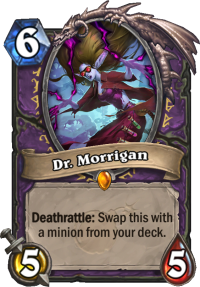
Dr. Morrigan is one of the worst cards Blizzard has released last year, and I mean it. It had simply no redeeming qualities – high mana cost, weak stats, questionable effect. And so, buffing her was a real challenge. They’ve decided to not be conservative and instead of a slight mana or stats tweak, they went ahead and reduced her cost by two. Two whole mana. And you know what? It’s still bad. Imagine taking an average card and reducing its mana cost by 2 – it would become busted. Even a stupid Boulderfist Ogre would be broken if reduced by 2. But Dr. Morrigan still sees no play.
That’s because the problem is not the mana cost, but the general concept behind this card. Ideally, you want to pull a big minion from her Deathrattle. So if you would play only big minions, she would be busted at 6 mana. But the problem is that you simply can’t run only big minions. Warlock doesn’t have nearly enough sustain to be able to drop all of the 1-3 mana minions. Even last rotation, when it had access to tools like Defile and Lesser Amethyst Spellstone, it still had to run at least some smaller minions.
I have to say that at 6 mana the card finally has some potential. Remember Possessed Lackey, which has seen play even at 6 mana? Of course, that’s because it could only pull a Demon, which means that you could still run small minions – just not Demons. But Morrigan has much, much better stats. So if Warlock gets some powerful, big mid-late game minions AND lots of early-mid game board control tools, then a deck with Morrigan might make sense. But until then, she will see exactly zero play.
17. Flark’s Boom-Zooka
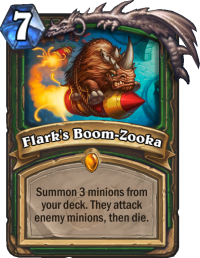
Right from the start, I felt like Flark’s Boom-Zooka was overhyped. The card is big, flashy and cool – but it’s just not good, no matter how you look at it. It’s a bit similar to Dr. Morrigan in a way that in order to make it work, you would need to build a deck around it with no small minions whatsoever. But even more – you’d want to build a deck with big minions that have Deathrattles or other kind of immediate impact besides their bodies. Since they die at the end of turn, playing just big minions would mean that you have to build your entire deck around an overpriced removal spell. While you can combo it with something like Revenge of the Wild – it’s still not a good way to use the card. You need to run only big Beasts (limiting yourself even further), rely on an 8 mana combo in a deck with no small minions and still be vulnerable to a single AoE clear with no real backup game plan (Boom-Zooka is Legendary so you can’t do it twice + the minions you pull are no longer in your deck). It’s a cute combo when it works, but it would need a lot to become viable.
Just like in case of Morrigan, the problem isn’t exactly its mana cost – it’s just impossible to build a good deck around it with the cards we have right now. And again, I’m not saying that it’s impossible in general, because I could easily see Blizzard printing cards that support this kind of play style. Hunter would need ways to get through the early/mid game, possibly more ways to summon minions (more cards like Flanking Strike would work very well), and then have some minions with very impactful Deathrattles that you want to trigger. Then do the same thing again with Zul'jin. But we’re still many, and I mean so many cards away from building a deck like that, which makes me doubt that we’ll ever see a working Boom-Zooka deck in Standard.
16. Cloning Device
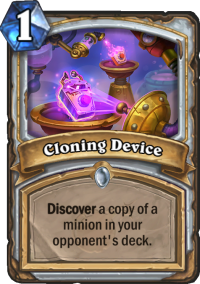
I always found Cloning Device to be a bit weird. It would make a lot of sense if it Discovered a minion from YOUR deck, something like Shadow Visions but for minions instead of spells. But getting one from your opponent’s deck and paying extra mana for it? Why would you want it?
Yes, of course, being able to DISCOVER it is a big advantage. Since you get three choices, you can pick whatever fits the current matchup best. But the thing is – since you’re pulling minions from your opponent’s deck, the chances are that most of them won’t work as well in your deck. Against faster decks, you’ll most likely get some small minion, or maybe something aggressive like Leeroy Jenkins. Maybe get some Mech that won’t work nearly as good in your deck since you have no other Mech synergies? Or a Pirate that will lose its potential, because you have no weapon? The situation is definitely better against Control decks – here you have a much higher chance to snatch something you might want to play yourself. But against Control, you’d rather have something that actually gives you card advantage. Even a stupid Thoughtsteal will usually be better, because it gives you +1 card advantage (while Cloning Device is no card advantage with a slight tempo loss).
Instead of Cloning Device, you’d rather put a solid minion into your deck. And that’s it. Buffing it from 2 to 1 mana made it better, but it’s still not a good card by any means.
15. Mulchmuncher
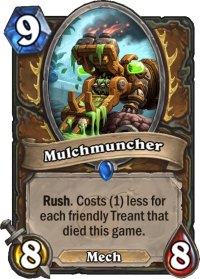
I was really excited for this card before it came out, but it turned out that not only a Token Druid built around Treants is simply worse than a non-Treant version, but that it’s actually pretty hard to make this card cheap. You only really started pumping Treants in the mid game, so it was hard to discount it early. And while let’s say 4 mana 8/8 with Rush would be absolutely nuts on Turn 4-5, it was no longer that good later in the game (don’t get me wrong – it would be good at any point in the game, but not “game-winning” good).
Reducing his mana cost by 1 didn’t change much. Of course – it’s a bit easier to play it for cheap now, but it still has the same problems. Token Druid is still not built around Treants, and the card still is only relevant in the late game, when its discount is no longer as impactful.
Of course, The Forest's Aid made it much easier to play a cheap or even free Mulchmuncher, but… again, in the late game. Let’s say that you play Aid on T8, everything dies, you do the same thing on T9, everything dies. You now have a free Mulchmuncher. But it’s Turn 10 already. If you just drew it, then it’s great, but if you were holding it from the beginning of the game, you’d rather it be any other card that could maybe get you back into the game earlier. And reducing its mana cost by 1 didn’t really change much. It was a fringe card before, and it’s still a fringe card.
14. Violet Haze
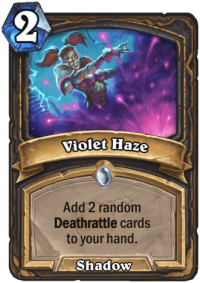
At 3 mana, Violet Haze was clearly overpriced. 3 mana is the baseline for drawing 2 cards (Arcane Intellect), but getting random cards is nearly always worse than getting cards from your deck. Sometimes even getting specific type of cards is worse than just drawing from your deck (e.g. Forge of Souls) because you need to play those cards, and you might draw them first making a card like that useless. That’s why similar cards were usually priced at 2 mana – even the recent Warrior’s Dragon Roar. And after the buffs, Violet Haze has joined them – and is where it should be from the start.
But is getting 2 random Deathrattle cards for 2 mana actually good? Well, yes and no. Getting some sort of card advantage for 2 mana is usually solid. Then, since it’s pretty cheap, you can often use it for the sake of spell synergies, or as a combo activator. On the other hand, Deathrattle cards aren’t most consistent in how strong they are. You can get something great, or something terrible, which already reduces the value of this card. Another thing is that most of the Rogue is a tempo class and not a value class – most of the value cards it runs also add some sort of tempo. For example, EVIL Miscreant gives you a sort of card advantage, but also adds a body to the board. This is important, because Rogue is really not doing well when it falls behind.
The reason I could see for playing this card is having a working Deathrattle Rogue deck. Random Deathrattle cards would be much better if you had some extra synergies for them. However, the problem is that Rogue doesn’t really have great Deathrattle synergies now. There are some ways to trigger Deathrattles – Necrium Blade and Necrium Vial – and while those are pretty good, it’s really not enough. No exceptional Deathrattle minions and no other reasons to run them make the deck unplayable. And until we see more synergies, I don’t think that Violet Haze will be playable.
13. Spirit Bomb
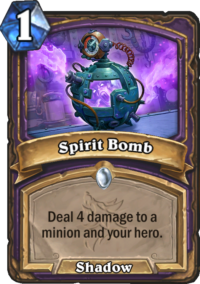
Spirit Bomb wasn’t a terrible card per se. 2 mana for 4 minion damage is good – I mean, Shadow Bolt has seen some play in the past (mostly out of necessity, but still) and it costs 3 mana. So you basically traded 4 health for 1 mana – something that certain Warlock decks might be willing to do. But as it turned out, slower Warlock decks didn’t want to sacrifice health, and faster Warlock decks didn’t need a minion-only removal.
Now it costs 1 mana, and it has much more potential. Instead of 1 mana discount, you get 2 mana discount over the regular removal. It clears most of the 3-drops and even some 4-drops for 1 mana, and that’s an amazing tempo gain. Of course – 4 life cost is still pretty big. Keep in mind that Warlock has lots of ways to damage itself, but very limited ways of refilling the lost health now. And realistically, with decks like Bomb Hunter or Bomb Warrior being popular, you can’t always afford to lose too much life without losing the game.
I think that the card was designed with some kind of “self-damage” Warlock in mind. But the problem was that most of the cards that benefited from Warlocks damaging themselves were… mediocre at best. Duskbat, Nethersoul Buster or Deathweb Spider are all meh. And Lesser Amethyst Spellstone could be activated much easier (Kobold Librarian, Vulgar Homunculus) + it’s gone from Standard now. The other synergies I’ve mentioned are still there, but they aren’t good enough to build a deck around.
Spirit Bomb is pretty good at 1 mana, but we would need a) more ways to regain lost health or b) more good ways to synergize with health loss.
12. Gloop Sprayer

Gloop Sprayer is like a definition of win-more card. When you’re behind on the board, it’s basically unplayable. When you have only small minions – it’s meh. When you have a single bigger minion – it’s also meh. In order to take full advantage of it, you need to have two big minions you want to copy. But if you have two big minions on the board, the chances are that you’re already winning. Reducing his mana cost by 1 didn’t change much in that department. Of course, making it 7 instead of 8 means that you can play him more easily. Or possibly even fit a 3-drop in the same turn, so even with just a single minion on the board you can still take bigger advantage of it.
However, the problem is that this kind of Druid play style was basically killed off by the nerfs + rotation. Ramp cards are now pretty bad, so playing a classic “Ramp into big minions” Druid, where this card might be good in is impossible. I really hope that Druid gets some new, good ways to ramp in the upcoming expansion. While I was not a fan of Wild Growth in every single Druid build, nerfing ramp so hard kind of killed the class’ main identity and that’s no good.
Right now the biggest reason to play this card and also the reason why it’s relatively high on this list is Lucentbark. While an off-meta deck, Lucentbark (Heal) Druid is a thing and it’s actually not THAT bad. The idea is to stick a Lucentbark and then start copying it. Gloop Sprayer is an amazing card in the deck after you already copy him once. You can turn 2 Lucentbarks on the board into four. And with four of them, any time you heal for 5, you end up with 4x 4/8 Taunt on the board. It’s not the most consistent deck, especially in a world where Mages can pump multiple 8/8 or 7/8’s with Taunt easily without a huge set-up, but with some more cards it can actually work okay in the upcoming expansions (right now it’s the only hope for slow Druid).
11. Unexpected Results
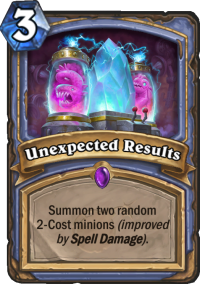
At 4 mana, Unexpected Results was a cute card. It was weak at the base level (2x random 2-drop for 4 mana is not good at all), but could be turned into something really powerful with Spell Damage. However, given that it was pretty hard to stack Spell Damage, and that the card was weak without it, it didn’t really see much play. However, when we buff it to 3 mana, things start to change a bit. Summoning 2x random 2-drop for 3 is not amazing, but it’s actually an okay baseline. Even at worst, the effect is not bad. Now, if we add some spell damage, it obviously gets even better.
While we don’t have any Mage decks built around Spell Damage (but we might, if Blizzard decides to push the theme even more), the card might not even need it. The thing is, it does work quite well in Cyclone Mage, and it sees play in some builds. It’s not very common, but unlike cards above it, it actually sees some play in a high tier meta deck. It synergizes very well with both Sorcerer's Apprentice (making it 2 mana means that you get 2 random 2-drops for a cost of one) as well as Khadgar (doubling the number of minions you summon). Now if there was some Spell Damage card that would fit into the build too, then Unexpected Results might become a staple. Since it’s not the case, though, we’ll have to wait and see what direction they want to push Mage in.
To be honest, Unexpected Results is one of the buffs I’ve overrated. I thought that the card is going to be amazing after it’s down to 3 mana. It’s not, but it’s certainly solid.
10 & 9. Beryllium Nullifier & Security Rover
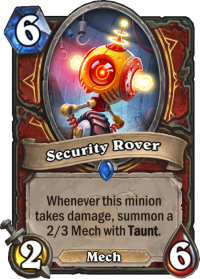
Funnily enough, neither of those cards see play in any decks on the ladder. In terms of the play rate, they are on the same level as the lowest cards on this list. So why they are so high, you might ask? Because even though they aren’t directly put into any Warrior decks, they are commonly seen in Warrior matchups. Since nearly every Warrior deck runs Omega Assembly and Dr. Boom, Mad Genius, it turns out that they are seen much more commonly than lots of the cards above. Both of them were already good picks before, and they became even better now.
Let’s start with what I think is the less impactful buff – Beryllium Nullifier. Bumping his attack from 3 to 4 might not seem like a big deal, but it turned him into a significantly bigger threat. Since he often has Rush when you get him (thanks, Dr. Boom), being able to immediately run him into a 4 health minion and kill him is a nice addition. 4 attack also means that you can put your opponent on a faster clock. It’s a great minion to discover in Warrior mirrors, especially. Because it is Elusive, Warrior can’t Shield Slam or Execute it. It’s also way out of range of cards like Warpath or Wrenchcalibur. The only card it can easily die to is Omega Devastator, but a good play around that is to Magnetize it into Eternium Rover. Before the buff, it was 4/11, so it didn’t die to Devastator’s Battlecry, but they could just run 4/5 into it and it survived at 1 health. Now, since it’s 5/11, they can still do it, but Devastator also dies.
However, the more impactful buff in my opinion was bumping Security Rover‘s health from 5 to 6. Health is very important on minions that do something when damaged. It means that, on average, you can trigger their effect more time before they die. Same goes for Security Rover. 6 health means that you can run him into 5 attack minion and it will still survive. It also means that you can e.g. clear one 2 health minion and it won’t die to 3 damage removal. There are lots of situations in which the extra health means that it will produce an extra 2/3 Taunt – and that’s big. Security Rover was already high on the priority list of cards you wanted to Discover, and right now it’s one of the best ones. And since it’s a Warrior card, it also shows more commonly than Neutrals.
While I don’t think that those cards will see direct play in Warrior, their buffs were huge because both Omega Assembly and Dr. Boom, Mad Genius will definitely be staples for the rest of this Standard year (unless they get nerfed).
8. Necromechanic
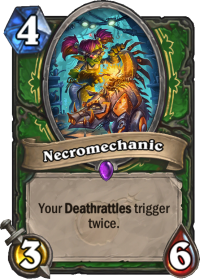
When it comes to pre-patch rankings, Necromechanic was definitely one of the highest cards on the list for many players. It was already almost playable at 5 mana, and buffing it to 4 made it really powerful. 3/6 are premium stats for a 4-drop (for a card with an ongoing effect, they’re even better than 4/5, because it’s harder to kill) and the text on a card is also something you can’t possibly ignore. It’s like a good old Baron Rivendare, but that one had nearly unplayable 1/7 stats (it also worked only on minions, as opposed to all Deathrattles, which is pretty relevant with Nine Lives).
The thing is that Deathrattle theme has been heavily pushed in Hunter for some time already. Even though lots of great Deathrattle-related cards have rotated out (Play Dead, Devilsaur Egg, Terrorscale Stalker etc.), we’ve got some new ones – this time in a form of Mechs. So a 4-drop that makes your Deathrattles trigger twice has massive potential. Spider Bomb, Ursatron, Mechanical Whelp, Oblivitron, they would all benefit heavily from another trigger. More value, more tempo, bigger board – you name it. In general, Deathrattle minions have a higher potential to stick to the board, so dropping Necromechanic next turn and trading one off can yield some amazing results. Not to mention that Nine Lives potential is huge. Let’s say that you drop Whelp on curve and it dies. Then on Turn 7 you play Mechanic + Nine Lives to discover it. You get 3/6 + 2x 7/7 on the board immediately and another Whelp in your hand.
And players were right – Necromechanic has found its home in Mech Hunter. It does not dominate the meta just yet, though. That’s simply because Bomb Hunter, a faster, more aggressive variant is better right now, so the slower, Deathrattle build is underplayed. Necromechanic is a little bit too slow in the faster build, since it doesn’t run enough impactful Deathrattles and it wants to focus on Mechs & Magnetize. But slower Mech build is not a bad deck by any means, and it might become THE Hunter deck to play depending on the meta and new cards printed in the upcoming sets.
7. The Storm Bringer
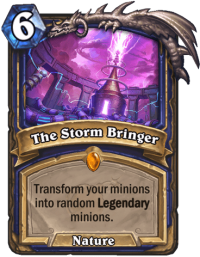
One of the Shaman’s theme is Evolving minions. It started way back in Whispers of the Old Gods with Evolve, then we’ve got cards like Unstable Evolution or Thrall, Deathseer. While most of those are out of Standard now (with Mutate being the only one left), we have a slightly different kind of “Evolve” effect too – The Storm Bringer. Most of the time, Evolve effects worked best on small minions with high mana cost – this way you could turn a small body (e.g. Doppelgangster) into something bigger (e.g. Boulderfist Ogre), thus upgrading your board significantly. Storm Bringer, while it fits a similar style of decks, works a bit differently. Instead of small minion with high mana cost, you want JUST small minion – no matter if it costs 0 or 5 mana. And that’s what the card excels at – turning a board of small minions, especially tokens, into random Legendaries. Of course, given that Blizzard has been printing many smaller/lower impact Legendaries in the past few sets, a “random Legendary” is no longer as menacing as it used to be. But it’s still a huge improvement over 1/1’s, for example.
The problem with this card was always sticking the board. When you play against Shaman and you realize that they’re using the Token strategy, you want to clear their board all the time. All the Totems, all the 1/1’s – just get rid of them, so you won’t get killed by Bloodlust out of nowhere. Which means that the previous 7 mana cost was a bit prohibitive, and reducing it by 1 made a huge difference. In lots of situations you need to stick your tokens for one turn less, you can also combo it with something much easier. For example, you can play a 1-drop + Voltaic Burst + Hero Power now, then follow up with Storm Bringer on Turn 10. Before you had one less mana, which would result in one less Legendary. Buff to Thunderhead also went a long way when it comes to Storm Bringer’s playability – Thunderhead is harder to remove, which means that you can (on average) produce more 1/1’s, which makes Storm Bringer even better.
Right now it sees play in almost 2% of the decks (R10-Legend, last 7 days), which might not seem like much, but it’s a huge improvement. The main reason why it’s not played more is, similarly to Necromechanic, the fact that a faster decks that don’t want to run it are just better right now. In case of Shaman, those are Murloc and Aggro Overload builds, which simply don’t have space for it (it’s too slow). However, a slower Overload/Token Shaman lists gladly play it, because next to Bloodlust it’s another way to benefit from a big board of small minions and turn the tides of a match completely.
6. Extra Arms
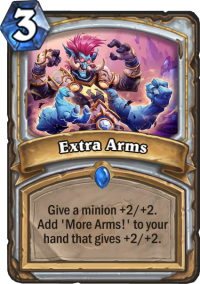
Let’s be honest – Priest is in a bad spot right now (in Standard, that is). Next to Warlock, it’s one of the two least played classes, but unlike Warlock, which has at least one decent deck (Zoo), Priest is all over the place. People run many different builds, none of which performs well. Funnily enough, the best Priest deck right now is… Mech Priest, which mostly relies on Neutral cards. And Extra Arms buff was actually the push needed to make it in the first place. So one can say that this buff is the biggest reason why Priest is even remotely relevant now.
Right now, the card is really and I mean really strong. It was already playable at 3 mana, mostly in some off-meta builds, but still. Right now at 2 mana it’s almost like a strictly better Blessing of Kings, in a class that historically could take a much better advantage of buffs. Since it’s split in two, it means that you can just play +4/+4 for 4 mana like BoK, but you can also play just +2/+2 for 2 mana and do something else, or split the +2/+2’s between two different minions. Two spells also means that you benefit twice for any effect that wants you to play spells, or cards (like now out-of-Standard Lyra the Sunshard). It’s just a great card in any Priest deck that’s either minion-based or Divine Spirit + Inner Fire combo-based.
Priest is not in a great spot, but Extra Arms is one of the most common Priest cards right now, but Extra Arms is played in over 60% of Priest decks on the ladder, making it one of the more popular buffed cards. And it was definitely a relevant one – without it, Priest would be in an even worse position in the meta. I believe that the card should see play all the way until rotation.
5. Glowstone Technician
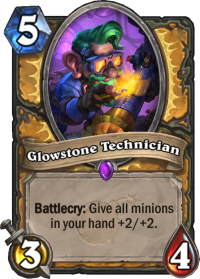
Remember Handbuff cards from Mean Streets of Gadgetzan? It was supposed to be Paladin’s theme for the expansion, but let’s be honest, it didn’t really work that well. There were some brief moments during which the deck was okay, but it was never amazing. So you can probably imagine that people weren’t exactly excited to see a Glowstone Technician when it first dropped. For a good reason – initially, the card was just too slow. Sure, giving your entire hand +2/+2 is good, but if you could only do it on Turn 6, it was no longer that relevant. If you played it in a faster deck, you didn’t have enough cards to play at that point, and slower Paladin decks weren’t minion-based.
However, after it got buffed to 5 mana, it changed the entire story. Given that this is often a card which really “starts” your game (because you want to play slowly and gather as many minions in your hand as possible before dropping it), getting to do your powerful stuff a turn earlier is massive. Glowstone Technician is now a staple in Mech Paladin, and frankly, it’s one of the better cards in the deck. After playing it quite extensively post-buff, I can easily say that it can turn the entire game around. While you still sacrifice some tempo initially, you now pay only 2 mana for a hand-wide +2/+2 buff. Even if you hit just 3-4 minions, that’s still big.
There are plenty of reasons why this card fits so perfectly into Mech build. First of all – you play Mechs with Rush (Skaterbot, Zilliax), which means that the extra stats might have immediate impact on the board. Then, lots of your Mech are Magnetic, which means the same thing if you already have a Mech on the board (or – actually – if you can play a Mech alongside one of the Rush minions I’ve named already, because they can also Magnetize). You also have a Taunt + Divine Shield combination in a form of Annoy-o-Module, which is a perfect buff target (you turn it into a better Sunwalker, which can also Magnetize). And finally, you run Mechano-Egg, which is not “active” at first (0/5), but if you buff it to 2/7, you can attack with it and trigger its Deathrattle. It all lines up perfectly, making Glowstone Technician a very important piece of the deck.
I can only imagine that the card will see more play in the upcoming sets too – since Divine Favor has rotated out to Hall of Fame, I think that Paladin will be pushed out more in the Midrange direction, which is a perfect style for this card. Not too fast to run out of minions before Turn 5, and not too slow to run mostly bigger minions + spells.
4. Pogo-Hopper
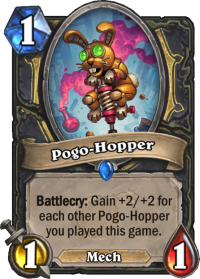
In terms of popularity boost, Pogo-Hopper was definitely the #1 buff at the beginning. From a niche card that nearly no one played, its popularity suddenly jumped to over 10% right after the buffs. Pogos were all over the ladder. However, as players have realized that Pogo Rogue is still not a great deck despite Pogo now costing 1 mana, its popularity steadily fell. Right now it sits at around 4.5% and it seems to have stabilized. Which is still a great score, don’t get me wrong.
Making Pogo-Hopper cost 1 made a big impact. It’s so much easier to consistently draw it (Witchwood Piper now always gets it even if you run other 2-drops) and combo it. Fitting a 1 mana card into your turn is way easier than fitting a card that costs twice as much. For example, playing 2x Pogo + Preparation + Vanish + 2x Pogo. Before the buff, you couldn’t even do it – you were 2 mana short (the whole combo would cost 12 mana). Right now it’s 8. Dropping a few Pogos + Barista Lynchen is also easier. Before, even three Pogos + Lynchen was impossible, because it would be 11 mana. Now you can do it for 8 mana. Combos with Spirit of the Shark, Lab Recruiter etc. all became much more consistent and easier to pull off. So looking at the deck this way, buffs made a massive difference.
That said, Pogo Rogue is still not a great deck, because while it can destroy those slow decks that want to grind you out, without perfect draws it stands no chance vs Aggro. Heck, not even Aggro per se – it struggles against decks that are even slightly more aggressive than average, like Bomb Warrior or Conjurer Mage (the matchups are slightly below 50%). And it gets demolished by the likes of Bomb Hunter and Aggro Overload Shaman (~30% matchups). The buffs did matter, because those matchups were even worse before – but just turning Pogo into a 1 mana card is not good enough. The deck needs more synergies, especially more ways to survive against Aggro to become good (or the meta needs to be really greedy).
Between you and me, however, I hope that it does not happen. Pogo Rogue is not a fun deck to play against with slow builds. It’s like Quest Rogue all over again – if you don’t beat them fast enough, you just lose).
3. Crystology
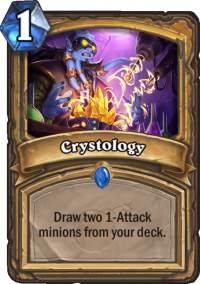
While Glowstone Technician’s buff was big, the card only fits into a narrow style of decks. Crystology, on the other hand, is a pretty universal one that can be played in all kinds of builds. Aggro deck can naturally run many 1 Attack minons – Argent Squire or Crystallizer come to mind. Mech build can play Skaterbot and Glow-Tron. A slower deck can use it to draw more card draw and utility cards – e.g. Novice Engineer, Bloodmage Thalnos, Crystalsmith Kangor. Even a deck built around Immortal Prelate loves that – since they are your main win conditions, you want to get them quickly so you can start buffing them (and even if they die without buffs, you can use your second copy to draw them too). All in all, I imagine that Crystology should see play in basically every Paladin deck. Even if it doesn’t fit that well, people will just force it in by adding some 1 Attack minions. Why? Because the card is so good that not including it would be a mistake.
Drawing 2 cards for 2 mana was already strong – it was one of the most played cards on the list before buffs. Now, drawing 2 cards for 1 mana is just insane. Even if the draws are limited only to 1-drops, it’s still one of the strongest draw cards we’ve seen up to date. But I don’t mind it at all – this is what Paladin needed. Between the rotation and losing Divine Favor to Hall of Fame, the class needed some kind of push. It’s strong, but its power level will always be limited by the fact that you can only draw 1 Attack minions. So unless they print some really broken ones, the card should remain a Paladin staple until next rotation, but won’t make the class too strong by itself.
2. Thunderhead
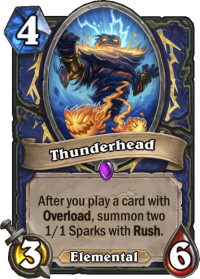
Similarly to Crystology, Thunderhead is an example of a card that was already good and playable before buffs. It didn’t see awful lot of play mostly because Shaman wasn’t in an amazing spot last year (ever since Saronite Chain Gang was nerfed to hit Shudderwock), and even if some Shaman decks were played, they usually weren’t built around Tokens/Overload cards. That said, the ability to spawn 2x 1/1 with Rush after every single Overload card is massive. It’s like a Violet Teacher on steroids – not only it was two per card, but also they had Rush, so you a) could have immediate impact on the board and b) you didn’t run out of space that easily, because you could always run them into something.
Buffing it from 3/5 to 3/6 might not seem like a huge deal, but it in fact is. Thunderhead is one of those cards which increase your chance to win heavily if it sticks. With an ongoing effect like that, as long as you had some Overload cards to fuel it, you dominated the game. And the truth is that each point of health matters. Early/mid game hard removal that just kills a minion no matter what are not very popular in the meta. Most of the removal deal only X damage, so increasing his health by 1 made a big difference. Not only it’s harder to kill with minion trades, but it dodges common removals like Shield Block + Shield Slam, Vendetta + dagger, a combination of Backstab / SI:7 Agent / 2 damage Lackey + Dagger, Frostbolt + Ray of Frost, Kill Command and so on and so on. It’s not like 6 health minion can’t be killed on Turn 4, but it’s significantly more difficult than killing a 5 health minion.
Thunderhead is a big reason why Shaman made a comeback in the post-buff meta. It’s a central piece of decks like Aggro Overload Shaman or Token Shaman. Right now it’s played in almost 7% of decks on the ladder, which is ~60% of the Shaman decks (the only deck he’s not present in is a classic Murloc build). IIRC, it had less than 1% play rate before the buffs, which is a really solid jump.
1. Luna’s Pocket Galaxy
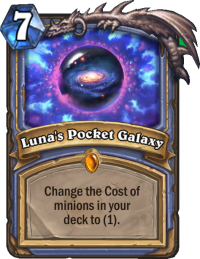
Now this is something I have not expected. It’s the only buff other than Dr. Morrigan in which card was changed not by 1 (mana cost, stat point), but by 2. Like I’ve already explained, this is massive – reducing the mana cost of an average card by 2 would usually make it broken. However, Luna’s Pocket Galaxy was never an average card. It was much harder to classify, because it gave player no immediate advantage. Before, you had to “waste” 7 mana on something that didn’t change the board state, life totals or card advantage in any way (or rather, you were down a card after playing it). That was obviously too much, and as a result, the card hasn’t really seen any common meta play. Until now.
2 mana points make a huge difference. While you still have to sacrifice a lot of tempo when playing it, you can now drop it earlier, or do something else when playing it more easily in the late game. For example, you can now play Pocket Galaxy + Frost Nova + Doomsayer in the late game, something that wasn’t possible before.
The effect was always strong, but only in specific deck. Ideally, you wanted to play a minion-heavy deck with lots of high mana, big bodies + combo cards like Archmage Antonidas or Malygos. The problem was that such a deck did not exist at the time (well, and the fact that Luna’s was very expensive). People tried to build a deck only around the combo aspect of this card, but it was a bad idea – the deck was simply not consistent, because you often drew your combo pieces before Luna’s. But if you build your entire deck around it, including big minions, it’s another story. Luckily for Mage players, Conjurer Mage already wanted to play this style. Thanks to Conjurer's Calling, Giants became much better, and given that the deck often had big hand sizes, Astromancer was also a great card to include. We also have a bit more combo-oriented deck built around the new Pocket Galaxy – Freeze Mage – although it doesn’t look a lot like the old build. It puts a much higher focus on minions, because relying only on Antonidas and Alexstrasza for the sake of Pocket Galaxy would make no sense.
All in all, it was clearly one of the better buffs, and in my opinion it’s THE most impactful change. A card that has seen virtually no play is now present in ~9.5% of the decks on ladder (and the number is still growing). While it wasn’t very popular right after the buffs patch, it’s quickly becoming a Mage staple thrown into almost any build.

I would swap the positions of Dr. Morrigan and the Boomzooka – met the first a view times, but didn’t see the second a single time.
Besides that, great article.
Actually, minions summoned by Flark’s Boom-Zooka die immediately not at the end of the turn, so you can combo it with revenge of the wild.
My bad, fixed that part. For some reason I confused it with Goblin Prank. It still doesn’t change anything NOW, but it does mean that the card has higher potential.
Yep indeed, Thank you for the article.
You say Pogo-hopper is not a great deck… Maybe it’s because of bad pogo-hopper decks and players who doesn’t understand how to play the deck, because pogo-hopper is definitely one of the most skilled decks to play right now.
And it’s still bad. I do understand that it’s not the easiest deck to play, but it doesn’t make as big of a difference as some people imagine. If the deck is difficult, it might lose 2 or 3% average win rate… but Pogo sits at ~45%, so even if we add the win rate lost due to “difficult deck tax”, it’s still bad. If it was great, but difficult, people would play it all over high Legend and in tournaments (like Patron Warrior was, for example). But they don’t. It’s not a terrible deck and it definitely has some good matchups, but it’s NOT a great deck.
It does see play in hct-grandmasters and it was one of the decks I used to grind to legend. I play a version with more board control and less shuffle and return effects. It’s really good.
Spell damage mage is actually legit. Played my own version of Kibler’s deck and it turned out really well. Went from rank 5 to 2. Then I played mech hunter and beast hunter to legend 😀
Dr. Morrrigan is not that bad. It’s acts a bit like Cairne Bloodhof and can either be stronger and weaker depending on the minions in the deck, and we all know Cairne Bloodhof is a very strong value minion. The problem with Dr. Morrigan is there is good control warlock at the moment.
Enjoyed the article!
Are you doing the most overrated/ underrated rise of shadows cards articles? – they’re always good fun.
Thanks!
I actually did both a ~month ago 🙂
Underrated: https://www.hearthstonetopdecks.com/most-underrated-cards-from-rise-of-shadows/
Overrated: https://www.hearthstonetopdecks.com/most-overrated-cards-from-rise-of-shadows/
Thanks!